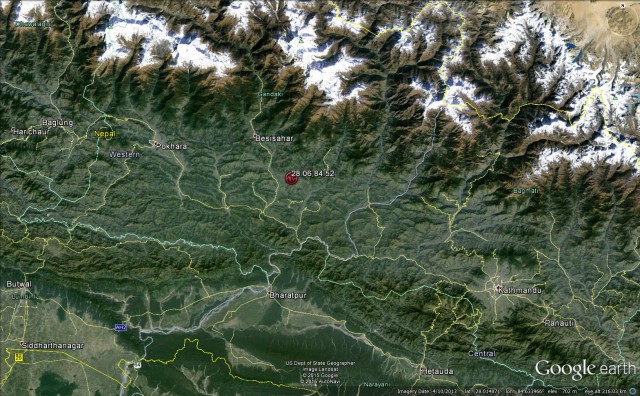25 April 2015
The M=7.9 earthquake in Nepal this morning
Posted by Dave Petley
The M=7.9 earthquake in Nepal this morning
NB updated to reflect the fact that this is now thought to be M=7.9 rather than M=7.6.
It appears that there was a large, shallow earthquake in Nepal this morning. The initial data suggests that this was a comparatively shallow event in the Central part of the country. Current data suggest:
M=7.5 at 11.9 km from the USGS
This will become clearer as the day wears on, but either way this is going to be serious. In terms of depth and magnitude this is generally comparable with the 2005 earthquake in Kashmir (updated: M=7.9 means that it is significantly larger), which killed over 70,000 in Pakistan and Nepal. Nepal has similar levels of vulnerability, but a lower capacity to cope (there is just a single runway at Kathmandu for example, and the armed forces are not well-equipped). The only thing that might help in this case is that the epicentral region does not contain a major city, but both Pokhara to the west and Kathmandu to the east are close enough to have been damaged. Kathmandu in particular is vulnerable, with poor quality buildings and soils that are prone to liquefaction, although in this case the distance should help. The Lamjung area itself is less densely population, which should reduce losses, but this is such a large earthquake that the effects will be severe.
This is the location as defined by the USGS:
.
So, we should expect extensive building damage with many thousands buried (there are already some images appearing on Twitter); serious damage to infrastructure, especially roads, telecommunications and electricity grids; and many landslides. This is likely to be a humanitarian crisis in the epicentral area, and with the monsoon just two months away the situation is going to be acute. The initial focus will be on Kathmandu, but the situation to the northwest of the city will be far worse. Expect to see little news from there for at least two days though.
Landslides are going to be a very serious problem. They will have caused losses; will have destroyed roads and other infrastructure, which will make the rescue and recovery operations very challenging; and they will continue to threaten the population. It is also likely that there are valley-blocking landslides in the mountains, which will be particularly problematic as the monsoon approaches. We need to find these very quickly.



 Dave Petley is the Vice-Chancellor of the University of Hull in the United Kingdom. His blog provides commentary and analysis of landslide events occurring worldwide, including the landslides themselves, latest research, and conferences and meetings.
Dave Petley is the Vice-Chancellor of the University of Hull in the United Kingdom. His blog provides commentary and analysis of landslide events occurring worldwide, including the landslides themselves, latest research, and conferences and meetings.
This is indeed serious. I have spent weeks in Nepal, out of Pokhara, in Kathmandu, and in the Khumbu-Rowaling regions. The summary here is a good preliminary assessment of the likely situation. I would add that there are also moraine-dammed lakes vulnerable to failure in the high Himalaya, with populated valleys below, and that unreinforced masonry construction in the Kathmandu valley is widespread.